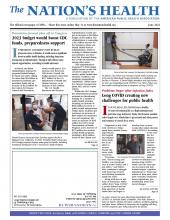
All children and Black Americans were undercounted in the 2020 census, which could impact health funding.
Photo by Rawpixel, courtesy iStockphoto
As some public health experts warned could happen, the 2020 Census undercounted people of color — again. The inaccurate results could have far-reaching ripple effects, as census data is used to formulate policy, funding levels, congressional representation and scientific research.
In March, the U.S. Census Bureau released the results of two analyses on the quality of the 2020 census, finding it undercounted the Black population, American Indian and Alaska Native people living on reservations, the Hispanic population and people who report being of “some other race.” In contrast, White and Asian populations were overcounted.
“Today’s results show statistical evidence that the quality of the 2020 census total population count is consistent with that of recent censuses,” said Census Bureau Director Robert Santos, MA, in a statement. “This is notable, given the unprecedented challenges of 2020. But...the 2020 census undercounted many of the same population groups we have historically undercounted, and it overcounted others.”
Such undercounts have been a persistent issue, but worsened with the 2020 survey. In 2010, for example, the Black undercount was about 2%, compared to more than 3% in 2020. The Hispanic undercount grew from about 1.5% to nearly 5%, while the undercount of American Indian and Alaska Native people living on reservations increased from 4.7% to 5.6%.
Health advocates are calling on officials to find ways to mitigate the inaccurate counts so that communities of color — many of which suffered a disproportionate toll during the COVID-19 pandemic — receive their fair share of funding and support.
“These results confirm our worst fears,” said Fawn Sharp, JD, president of the National Congress of American Indians. “Every undercounted household and individual in our communities means lost funding and resources that are desperately needed to address the significant disparities we face.”
Marc Morial, JD, president and CEO of the National Urban League, said he is “very concerned” that the undercount will reduce representation of Black and brown communities in legislative bodies, which could impact funding for local services and programs. He noted that the census has never been able to conduct a complete count of the populations.
“This is the institutionalization of population suppression,” Morial told The Nation’s Health. “And population suppression and voter suppression equal power suppression.”
The National Urban League called for actions to address the 2020 undercount and prevent future ones, including making it easier for jurisdictions to challenge their census numbers and using more equity-based designs in future surveys.
“These data are used to make critical decisions and if inaccurate numbers are used, there’s no doubt that undercounted communities will get short-changed,” Morial said.
Diana Elliott, PhD, senior fellow at the Urban Institute, which had also warned of inaccurate 2020 data, said systemic issues undergird recurring undercounts. For example, census survey methods are often better at capturing homeowners, rather than renters. Census researchers also use administrative records to fill gaps, the biggest of which is tax data. Elliott said the method can miss many people who live in undercounted communities who do not earn enough to file taxes.
Beyond race and ethnicity, the census also mistallied some groups by age. In particular, young children, particularly babies and toddlers up to age 4, were undercounted. Elliott said she is especially concerned about the undercount implications for young children in communities of color.
“If you have whole neighborhoods where the undercount is higher, that could mean for the next 10 years, schools don’t get as much funding, health care systems don’t get as much, infrastructure doesn’t get as much,” she said.
To remedy the problem, she said lawmakers can still choose to account for the 2020 undercount when making policy decisions.
“Undercounted communities are the ones that typically need funding the most,” she said. “So this really speaks to issues of fairness.”
For more information on the 2020 census undercount, visit www.census.gov and www.urban.org.
- Copyright The Nation’s Health, American Public Health Association









